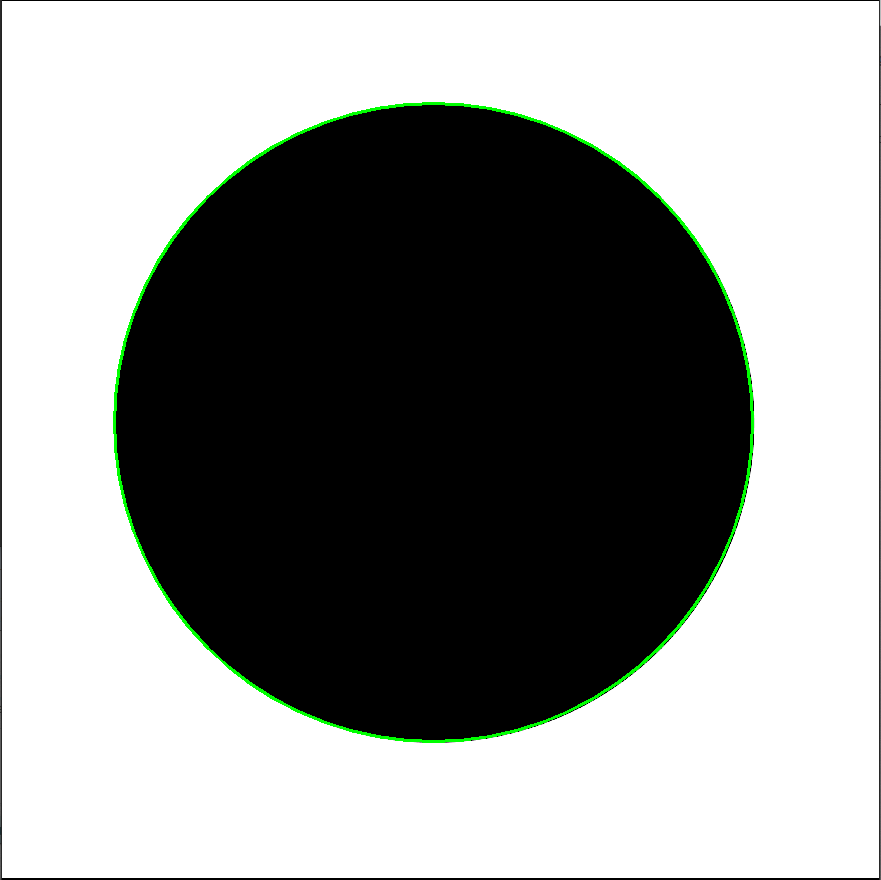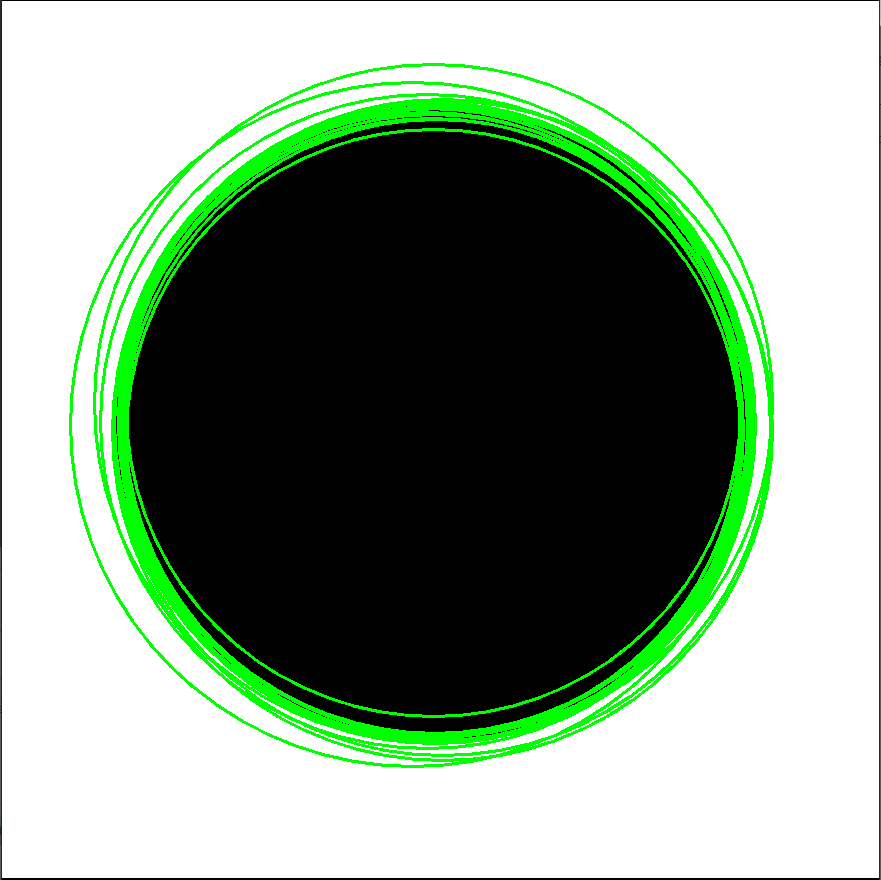This forum is disabled, please visit https://forum.opencv.org
 | 1 | initial version |
Try this:
#!/usr/bin/env python
#OpenCV 4.4.0, RPI 3B/3B+, 4B/4/8gb, Buster v10
#Date: 21th October, 2020
import cv2
import numpy as np
image = cv2.imread('circle.png')
output = image.copy()
img = cv2.cvtColor(image, cv2.COLOR_BGR2GRAY)
# Find circles
circles = cv2.HoughCircles(img, cv2.HOUGH_GRADIENT, 1.5, 100)
# If some circle is found
if circles is not None:
# Get the (x, y, r) as integers
circles = np.round(circles[0, :]).astype("int")
print(circles)
# loop over the circles
for (x, y, r) in circles:
cv2.circle(output, (x, y), r, (0, 255, 0), 2)
# show the output image
cv2.imshow("circle",output)
cv2.imwrite('circleA.png', output)
cv2.waitKey(0)
Output:

 | 2 | No.2 Revision |
Try this:
#!/usr/bin/env python
#OpenCV 4.4.0, RPI 3B/3B+, 4B/4/8gb, Buster v10
#Date: 21th October, 2020
import cv2
import numpy as np
image = cv2.imread('circle.png')
output = image.copy()
img = cv2.cvtColor(image, cv2.COLOR_BGR2GRAY)
# Find circles
circles = cv2.HoughCircles(img, cv2.HOUGH_GRADIENT, 1.5, 100)
# If some circle is found
if circles is not None:
# Get the (x, y, r) as integers
circles = np.round(circles[0, :]).astype("int")
print(circles)
# loop over the circles
for (x, y, r) in circles:
cv2.circle(output, (x, y), r, (0, 255, 0), 2)
# show the output image
cv2.imshow("circle",output)
cv2.imwrite('circleA.png', output)
cv2.waitKey(0)
Output:

If u using this cv2.HoughCircles(gray, cv2.HOUGH_GRADIENT_ALT, 1.5, 1, 300, 0.9). U get this.
Output:

 | 3 | No.3 Revision |
Try this:
#!/usr/bin/env python
#OpenCV 4.4.0, RPI 3B/3B+, 4B/4/8gb, Buster v10
#Date: 21th October, 2020
import cv2
import numpy as np
image = cv2.imread('circle.png')
output = image.copy()
img = cv2.cvtColor(image, cv2.COLOR_BGR2GRAY)
# Find circles
circles = cv2.HoughCircles(img, cv2.HOUGH_GRADIENT, 1.5, 100)
# If some circle is found
if circles is not None:
# Get the (x, y, r) as integers
circles = np.round(circles[0, :]).astype("int")
print(circles)
# loop over the circles
for (x, y, r) in circles:
cv2.circle(output, (x, y), r, (0, 255, 0), 2)
# show the output image
cv2.imshow("circle",output)
cv2.imwrite('circleA.png', output)
cv2.waitKey(0)
Output:

If u using this cv2.HoughCircles(gray, cv2.HOUGH_GRADIENT_ALT, 1.5, 1, 300, 0.9). U get this.
Output:

Apologised. I didn't see this cv2.HOUGH_GRADIENT_ALT. Here is code:
import cv2
img = cv2.imread('circle.png')
img2 = img.copy()
img_gray = cv2.cvtColor(img, cv2.COLOR_BGR2GRAY)
circles = cv2.HoughCircles(img_gray, cv2.HOUGH_GRADIENT_ALT,
2, 30, param1=300,
param2=0.85, minRadius=20)
print(circles)
for circle in circles[0]:
center_x, center_y, radius = circle
cv2.circle(img2, (center_x, center_y), int(radius),(0, 0, 255), 2)
cv2.imwrite('circle4.png', img2)
cv2.imshow("img2", img2)
cv2.waitKey(0)
cv2.destroyAllWindows()
Output:

 | 4 | No.4 Revision |
Try this:
#!/usr/bin/env python
#OpenCV 4.4.0, RPI 3B/3B+, 4B/4/8gb, Buster v10
#Date: 21th October, 2020
import cv2
import numpy as np
image = cv2.imread('circle.png')
output = image.copy()
img = cv2.cvtColor(image, cv2.COLOR_BGR2GRAY)
# Find circles
circles = cv2.HoughCircles(img, cv2.HOUGH_GRADIENT, 1.5, 100)
# If some circle is found
if circles is not None:
# Get the (x, y, r) as integers
circles = np.round(circles[0, :]).astype("int")
print(circles)
# loop over the circles
for (x, y, r) in circles:
cv2.circle(output, (x, y), r, (0, 255, 0), 2)
# show the output image
cv2.imshow("circle",output)
cv2.imwrite('circleA.png', output)
cv2.waitKey(0)
Output:

If u using this cv2.HoughCircles(gray, cv2.HOUGH_GRADIENT_ALT, 1.5, 1, 300, 0.9). U get this.
Output:

Apologised. I didn't see this cv2.HOUGH_GRADIENT_ALT. Here is code:
import cv2
img = cv2.imread('circle.png')
img2 = img.copy()
img_gray = cv2.cvtColor(img, cv2.cvtColor(img2, cv2.COLOR_BGR2GRAY)
circles = cv2.HoughCircles(img_gray, cv2.HOUGH_GRADIENT_ALT,
2, 30, param1=300,
param2=0.85, minRadius=20)
print(circles)
for circle in circles[0]:
center_x, center_y, radius = circle
cv2.circle(img2, (center_x, center_y), int(radius),(0, 0, 255), 2)
cv2.imwrite('circle4.png', img2)
cv2.imshow("img2", img2)
cv2.waitKey(0)
cv2.destroyAllWindows()
Output:
